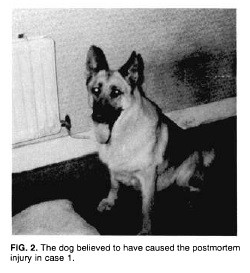Have you ever pondered the peculiar habits of your feline friend? As a cat behaviorist, I’m often met with a barrage of questions from curious cat owners. While I’m always ready to delve into the intricacies of feline happiness or the optimal number of litter boxes, the questions that truly pique public interest are often more… morbid. “Does my cat secretly despise my partner?” or “Is my cat’s bizarre behavior linked to the lunar cycle?” are common queries. But there’s one question that surfaces with surprising frequency and intensity: “Would my cat eat me if I died?”
The internet is awash with this concern. A simple Google search for “will your pet eat you when you die” yields hundreds of millions of results, suggesting a widespread, if somewhat unsettling, curiosity. Perhaps this apprehension isn’t entirely unfounded. Scientific evidence, while not explicitly designed to answer this question, does point towards a rather blunt truth: yes, your cat would likely eat you.
A fascinating study published in the Journal of Forensic Sciences, titled “The scavenging patterns of feral cats on human remains in an outdoors setting,” provides some unexpected insight into this very question. It’s important to note that the researchers weren’t intentionally investigating feline cannibalistic tendencies. They were studying human decomposition patterns in an outdoor environment. However, in the unpredictable world of scientific research, serendipitous discoveries often emerge. And in this case, the unexpected discovery involved cats and human remains.
The research took place at the Forensic Investigation Research Station (FIRS) in Colorado, a facility dedicated to the study of human decomposition. If you find this topic intriguing, I highly recommend Mary Roach’s captivating book, “Stiff: The Curious Lives of Human Cadavers,” which delves into the fascinating science of body donation. FIRS maintains an outdoor “decomposition facility,” secured by fencing to deter large scavengers and equipped with surveillance to monitor natural decomposition processes, including the activity of smaller creatures like birds, insects, and rodents.
The study documented an intriguing incident: five days after a body was placed in the outdoor facility, a “striped cat” managed to bypass security and was observed consuming the remains. The body belonged to a 79-year-old woman, a detail that, regrettably, fits certain demographic patterns in such studies. The cat focused its scavenging on the left arm and chest area. To prevent further disruption to the ongoing decomposition research, researchers placed a cage around the body for a week, temporarily interrupting the feline feast. However, upon removal of the cage, the determined cat returned and continued to scavenge from the same body for approximately a month.
Subsequently, a second cat, described as all-black, appeared at the facility. Researchers allowed this cat to scavenge unhindered. This cat chose the body of a 70-year-old man, which had been in the facility for nearly a week. Similar to the first cat, this feline exhibited a preference for the left side of the body, focusing on the arm and abdomen. This second cat made a total of 12 visits over roughly six weeks, consistently returning to the same body.
 A focused tabby cat with green eyes, showcasing its hunter instincts.
A focused tabby cat with green eyes, showcasing its hunter instincts.
In both instances, the cats displayed a distinct preference – both for a specific body and for particular areas on that body. Despite having access to around 40 other bodies, and with new bodies being introduced and removed, each cat consistently returned to their chosen body. Interestingly, both cats also seemed to favor areas where tissue damage was already present, even though the bodies were considered to be in the earlier stages of decomposition.
Before you jump to conclusions and castigate cats as morbid monsters, it’s crucial to consider the broader context. This discovery is noteworthy not merely for its macabre appeal, but because cats are inherently hunters, not scavengers. Scavenging is a behavior more commonly associated with canines, and it’s rarely observed in wild feline species. This study, therefore, raises the possibility that scavenging behavior in domestic cats might be more prevalent than previously thought, or perhaps triggered by factors like extreme hunger.
Now, before you rush to embrace your dog, convinced of their unwavering loyalty compared to your potentially cannibalistic cat, consider this: a deeper dive into forensic science literature, prompted by a Google Scholar search for “postmortem injuries pets,” reveals that indoor pets, including dogs, do occasionally consume their deceased human companions. It appears that while your dog may adore you, their survival instincts can override that affection when faced with prolonged isolation and the availability of a food source – even if they aren’t necessarily starving! Cases have been documented where dogs have been found near their deceased owners with bowls full of pet food, yet their stomachs contained human flesh. Intriguingly, even a golden hamster has been recorded engaging in postmortem nibbling of its owner.
A 1994 publication in the American Journal of Forensic Medicine and Pathology, titled “Postmortem Injuries by Indoor Pets,” identified key factors that increase the risk of pets consuming their owners after death:
- Free-roaming pets within the home: Unrestricted access to the deceased owner increases the likelihood of scavenging.
- Social isolation: Delayed discovery of the body, common in cases of social isolation, prolongs the time pets are without food and water, increasing the chances of scavenging.
- Pre-existing health conditions leading to sudden death: These situations often occur unexpectedly, leaving pets unattended and potentially hungry.
Some researchers propose that in cases where scavenging occurs shortly after death, it may not always be driven by hunger. Instead, it could be an attempt by the pet to seek attention or even revive their seemingly unresponsive owner. However, a significant number of postmortem injuries inflicted by pets do appear to be hunger-motivated. Tragically, many pets who resorted to eating their owners subsequently died of starvation themselves, or, in one documented case, succumbed to poisoning from ingesting drugs their owner had overdosed on.
So, to definitively answer the initial question: would your cat eat you if you died? Yes, it is a distinct possibility. And, perhaps surprisingly, so would your dog. Our beloved pets operate without a moral compass that prohibits consuming flesh, even that of their providers. They don’t adhere to the human concept of a sacred bond that should never be violated. The paradox lies in our own complex relationship with animals, where we grapple with the ethical implications of eating some species while cherishing others. But to our pets, in the stark reality of death, we may simply become another source of sustenance.
Acknowledgement: Thank you to Julie Hecht for her valuable feedback on this article.
References:
Garcia, S., Smith, A., Baigent, C., & Connor, M. (2019). The Scavenging Patterns of Feral Cats on Human Remains in an Outdoor Setting. Journal of Forensic Sciences.
Herzog, H. (2010). Some we love, some we hate, some we eat. Harper Books.
Roach, M. (2003). Stiff: The Curious Lives of Human Cadavers. W.W. Norton & Company.
Rossi, M. L., Shahrom, A. W., Chapman, R. C., & Vanezis, P. (1994). Postmortem injuries by indoor pets. The American Journal of Forensic Medicine and Pathology, 15(2), 105-109.
Suntirukpong, A., Mann, R. W., & DeFreytas, J. R. (2017). Postmortem Scavenging of Human Remains by Domestic Cats. Siriraj Medical Journal, 69(6), 384-387.

